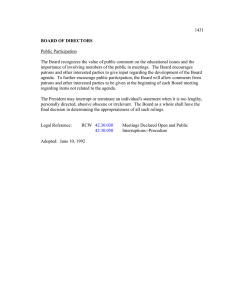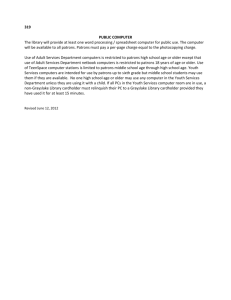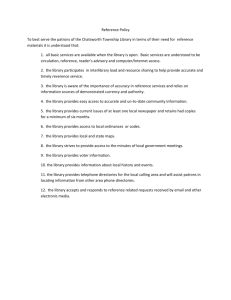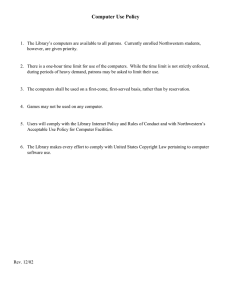Stadium Alcohol Management
advertisement
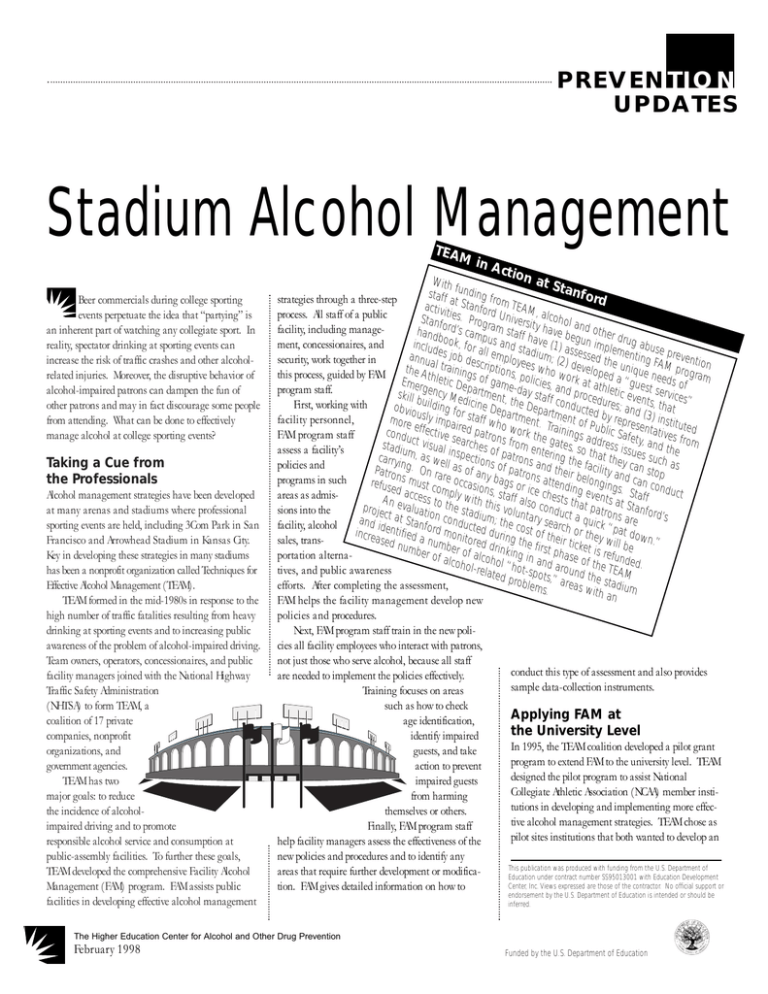
PREVENTION U P D AT E S Stadium Alcohol Management TEA M in Beer commercials during college sporting events perpetuate the idea that “partying” is an inherent part of watching any collegiate sport. In reality, spectator drinking at sporting events can increase the risk of traffic crashes and other alcoholrelated injuries. Moreover, the disruptive behavior of alcohol-impaired patrons can dampen the fun of other patrons and may in fact discourage some people from attending. What can be done to effectively manage alcohol at college sporting events? Taking a Cue from the Professionals Alcohol management strategies have been developed at many arenas and stadiums where professional sporting events are held, including 3Com Park in San Francisco and Arrowhead Stadium in Kansas City. Key in developing these strategies in many stadiums has been a nonprofit organization called Techniques for Effective Alcohol Management (TEAM). TEAM formed in the mid-1980s in response to the high number of traffic fatalities resulting from heavy drinking at sporting events and to increasing public awareness of the problem of alcohol-impaired driving. Team owners, operators, concessionaires, and public facility managers joined with the National Highway Traffic Safety Administration (NHTSA) to form TEAM, a coalition of 17 private companies, nonprofit organizations, and government agencies. TEAM has two major goals: to reduce the incidence of alcoholimpaired driving and to promote responsible alcohol service and consumption at public-assembly facilities. To further these goals, TEAM developed the comprehensive Facility Alcohol Management (FAM) program. FAM assists public facilities in developing effective alcohol management Acti on a With t Sta f u n d nfor staff i strategies through a three-step at Sta ng from T d activi E n ties. ford Un AM, alco process. All staff of a public iversi Stanf hol a Progr t o facility, including managehand rd’s cam am staff y have be nd other p d h b includ ook, for us and st ave (1) a gun imple rug abus ment, concessionaires, and a e s a m e l s d l annu s job de employ ium; (2 essed th enting F preventi security, work together in ) dev o al tra script ees w e A u n ique M progr n elope the A ining ions, ho w this process, guided by FAM n a Emer thletic De s of game policies, a ork at at d a “gues eeds of m h p g program staff. skill b ency Me artment, -day staff nd proced letic even t services” d t c u i h o c First, working with obvio ilding fo ine Dep e Depar nducted ures; and ts, that more usly impa r staff wh artment. tment of P by repre (3) institu facility personnel, se ir o Tr t e u c ondu ffective s ed patron work the ainings a blic Safet ntatives f ed FAM program staff e d c s r y g a t d , f a r r r v and t om ches tes, s ess is om e isual stadi h o o n assess a facility’s s u i carry m, as we nspection f patrons tering the that they ues such e ing. a ll as s a c f policies and n a o a d c f n ility a patro their On ra of an Patro stop s n n b y n programs in such refus s must c re occasio bags or s attendi elonging d can con omp ed a ng e s. S ice c ns, duct areas as admisAn ev ccess to t ly with th staff also hests tha vents at S taff h i t c s t a p o e a p luatio volu rojec nduc nford atro stad sions into the ’s and i t at Stan n conduc ium; the ntary sear t a quick ns are facility, alcohol ford denti c c “ t o h e p s d a o t t m r d incre o f ased ied a num onitored uring the f their tic they will down.” sales, transnumb b k d f b er of er of alco rinking in irst phase et is refun e portation alternaalcoh ded. hol “ o a f n da the ol-rel h tives, and public awareness ated ot-spots, round the TEAM ” probl efforts. After completing the assessment, ems. areas wi stadium th an FAM helps the facility management develop new policies and procedures. Next, FAM program staff train in the new policies all facility employees who interact with patrons, not just those who serve alcohol, because all staff conduct this type of assessment and also provides are needed to implement the policies effectively. sample data-collection instruments. Training focuses on areas such as how to check Applying FAM at age identification, the University Level identify impaired In 1995, the TEAM coalition developed a pilot grant guests, and take program to extend FAM to the university level. TEAM action to prevent designed the pilot program to assist National impaired guests Collegiate Athletic Association (NCAA) member instifrom harming tutions in developing and implementing more effecthemselves or others. tive alcohol management strategies. TEAM chose as Finally, FAM program staff pilot sites institutions that both wanted to develop an help facility managers assess the effectiveness of the new policies and procedures and to identify any This publication was produced with funding from the U.S. Department of areas that require further development or modificaEducation under contract number SS95013001 with Education Development Center, Inc. Views expressed are those of the contractor. No official support or tion. FAM gives detailed information on how to endorsement by the U.S. Department of Education is intended or should be inferred. The Higher Education Center for Alcohol and Other Drug Prevention February 1998 Funded by the U.S. Department of Education For additional information, contact : The Higher Education Center for Alcohol and Other Drug Prevention, EDC, 55 Chapel Street, Newton, MA 02158-1060 800-676-1730 HigherEdCtr@edc.org http://www.edc.org/hec/ PREVENTION U P D AT E S Tailg atin alcohol management strategy for their athletic facilities and that had appointed an on-campus coordinator to work with the TEAM coalition. Four universities were selected as pilot sites for this program: Stanford University, Northern Michigan University, Colorado State University, and Texas A&M University at Kingsville. It is true that many NCAA institutions do not sell alcohol during sporting events. Even so, alcoholrelated problems still occur during sporting events at these institutions because many patrons either drink before attending events or attempt to bring alcohol into the facility with them. Elise Lenox, director of the Alcohol and Other Drug Abuse Prevention program at Stanford University, described the situation at Stanford games: Stanford does not sell or serve alcohol in their sports facilities. It does, however, allow for the sale and lawful distribution of alcohol outside the stadium. At Stanford, alumni association pregame activities frequently provide alcohol to invited guests. In addition, some students at Stanford either drink in their residences prior to sporting events or attend tailgate parties. These issues need to be addressed in an effective alcohol management strategy. Alcohol Management Strategies TEAM develops alcohol management strategies in four areas: transportation alternatives, admissions policies, public communications, and vending practices. A comprehensive alcohol management plan for a university facility can draw from each of these areas. For example, a university stadium can provide its patrons with transportation alternatives, such as a free shuttle service back to campus residence halls or subsidized cab rides for impaired guests. In addition, a facility can offer nonalcoholic beverages at reduced prices to guests who are “designated drivers.” Admissions policies that can be implemented as part of an overall alcohol management plan include having security patrols in parking lots to detect drinking by patrons, confiscating any alcoholic beverages that patrons try to bring into the facility, and providing a special security patrol to deal with impaired patrons. Strict enforcement of admissions policies can be effective in preventing alcohol-related problems inside a stadium. In facilities that allow alcohol sales, public communications strategies can include having messages about responsible drinking printed on buttons, signs, or beverage cups. Universities can also launch public communications campaigns on g Over their campuses aimed at preventing excessive th m ente e past f pregame alcohol consumption. For example, gatin d a num ew years, be g. these campaigns could remind patrons that a B lcoho These ch r of chan oston Co ges t l l ange -relat impaired guests are not allowed to enter the is p o the lege (BC) s see ed pr ermit i has r m o p t b sports facility and that admissions policies follo e t wing d. BC’s c lems at t o have re olicies on impleh : d tailu o u are strictly enforced. rrent s tailga e events ced • w t Modifying vending practices can be a ing p h Patro olicie ere tailg a retur ns who le s incl key policy development area for those n wh ude t ting a ve th i h l e • e e t st facilities that sell alcohol. Facility he ga Tailga me is adium ar t i n g e still in is two h employees can implement a number no ours allowed progr t permitt only after ed to of strategies to help control patrons’ • Exc ess. fo the g es ame. r two ho alcohol consumption. Some faciliallow sive quan u rs be fore a are s ed in the tities of a ties halt alcohol sales either at a nd lcoho toppe tailga p l d t o ( i e n a l . i g are specific time before the game nd ch cy. g., ke a; gs ecked ends or at any time that trouble • If tailg in an cars enter ) are not a e t f ing p fort t ing the direc seems to be developing due to riv o enf a t orce rea can t or contac ileges are this alcohol consumption. Other ake f ts the a b us u neces sary p rther actio person w ed, the at facilities place limits on the • n e r , m i nclud ith the p hletic Alcoh it. number of beers that can be riv ing re alcoh ol is proh mova ileges an ibited ol ca purchased in a single trip. d l of t n be • B he evicte from the C po Smaller cup sizes may s l d and m tadium unde ice stop ; ay fa also help reduce the r age p ce fu patrons w 21. atrons ca • T r ther s it r h r volume of alcohol that e ath ying ancti h alcoh letic s i o b d ns. l o e i a patron consumes. l if th re ey lo with tailgating ctor send o t s t k ailga Facilities can also ting p o season informat • T io he Al rivileg ticket offer free or u holde n about r es. mode mni Off e rs an ice p reduced-priced soft ration d alu sponromo . m ni t e s the drinks to patrons who idea o f alco pledge to remain alcohol free so hol in that they can drive their friends home after the event. Strategies such as these can contribute to a safer and more enjoyable event for all patrons. Resources Organizations For more information on TEAM, please contact Heidi Puff at the TEAM Secretariat, Global Exchange, 7910 Woodmont Avenue, Suite 400, Bethesda, MD 20814; (301) 656-3100. Higher Education Center for Alcohol and Other Drug Prevention, reprinted 1997. Available from the Higher Education Center. Provides a guide for developing and instituting effective alcohol prevention policies. For information specific to the FAM program initiative at the university level, please contact Frank Uryasz, director of Sports Sciences of the National Collegiate Athletic Association, at (913) 339-1906. Alcohol Practices, Policies, and Potentials of American Colleges and Universities: An OSAP White Paper, by L. Eigen. Rockville, Md.: U.S. Department of Health and Human Services, Office for Substance Abuse Prevention, 1991. Available from NCADI (1-800-729-6686). Describes strategies colleges can implement as part of a comprehensive AOD prevention effort. Publications Setting and Improving Policies for Reducing Alcohol and Other Drug Problems on Campus: A Guide for Administrators, by W. DeJong and S. Langenbahn. Washington, D.C.: U.S. Department of Education, The Higher Education Center for Alcohol and Other Drug Prevention
